Maasai Mara is a spectacular place that is home not only to a large variety of wildlife but also a few nomadic Maasai tribes. Living inside or near national reserves has allowed the Maasai to add tourism to their revenue sources, but has barely modernized their way of life. In Maasai Mara National Reserve you can visit a Maasai village and see their traditional way of life.
Between climbing trips on Mount Kenya and Mount Kilimanjaro we went on safaris in Kenya’s Maasai Mara National Reserve and Lake Nakuru National Park.
Maasai Village
Our guide arranged for a young man from a local Maasai tribe to join us for a day and give us a tour of his village. The young Maasai explained a little about Maasai culture as we drove to his village, which was inside the Maasai Mara National Reserve. Maasai are nomadic cattle farmers, following the rain to find grass for their cattle. Cows are an important part of Maasai’s beliefs and culture. They believe that their god, Enkai, brought cows from heaven and gave all of the cows in the world to the Maasai. Each day young men and boys take the cattle out into the savannah to find grass. Their main role is to protect the cows from lions. They carry spears and bows and arrows for weapons.
Their main diet is beef, milk, potatoes and corn but also includes cow’s blood during traditional ceremonies. They drain enough blood from a live cow to be used during the ceremony, but not enough to kill the animal. The wound is sealed with cow dung. We were glad we didn’t see that tradition.

Maasai boys, Maasai Mara National Reserve
We entered the village through a lion-proof, spikey fence that surrounds the village. Inside were a few one-room homes made from a mixture of cow dung, cow urine, sticks and mud. The homes form a semi circle leaving an open central area for their cows to be housed at night.
Women dressed in bright colours came to welcome us. Many had colourful beaded earrings hanging from their stretched earlobes. They were eager to sell us their home-made bracelets and necklaces. Their children were very shy, not wanting to get too close.
Men wear a traditional red shawl over a red tunic and carried a spear. Hand picked young men are sent on perilous challenges. The successful ones become warriors and are responsible for the safety of the village. They are differentiated by their hair. Warriors are the only ones allowed to wear their hair long, usually in braids. They also carry a rungu; a wooden club with a round end used in hunting.
One fun tradition we saw, was when the warriors had a jumping contest. Maasai are typically tall, and they can jump very high. We were told that the one who jumps the highest gets the girl.

Maasai women, Maasai Mara National Reserve 
Maasai warriors, Maasai Mara National Reserve 
Maasai warriors in a jumping competition, Maasai Mara National Reserve
We were invited to enter one of the houses. They have no electricity or running water. Smoke from the cow dung fire filled the the small room. The combination of smoke and cow dung was unbearable and we could only stay inside for a few minutes. The smell wasn’t much better outside since it is essentially a cow paddock. We were constantly swatting away thousands of flies, but the Maasai didn’t seem to be bothered by them.

Maasai village, Maasai Mara National Reserve 
Maasai village, Maasai Mara National Reserve 
Maasai children, Maasai Mara National Reserve
Our Maasai guide said he had been sent to Nairobi for school as a form of punishment. Usually one child from each large Maasai family is sent to the city for school. It’s the ‘bad’ child that is sent away. The ‘good’ children stay with their family. After spending time in the village, we thought we’d prefer to be the ones be sent to the city.
Maasai Mara National Reserve
As well as visiting the Maasai village we went on a wildlife safari in Maasai Mara National Reserve. Although much smaller than Serengeti in Tanzania, they share a border and have a very similar landscape and wildlife. Our driver took us to the Tanzania side where we stepped across for a few minutes. It’s not officially allowed, but not patrolled and probably done be most of the tourists to the park.
As we found in Serengeti, the open savannah grassland allowed us to see animals in every direction. The two days spent in this park were filled with amazing wildlife sightings.

Giraffe between Acacia trees, Maasai Mara National Reserve 
Impala, Maasai Mara National Reserve 
Maasai Maara National Reserve 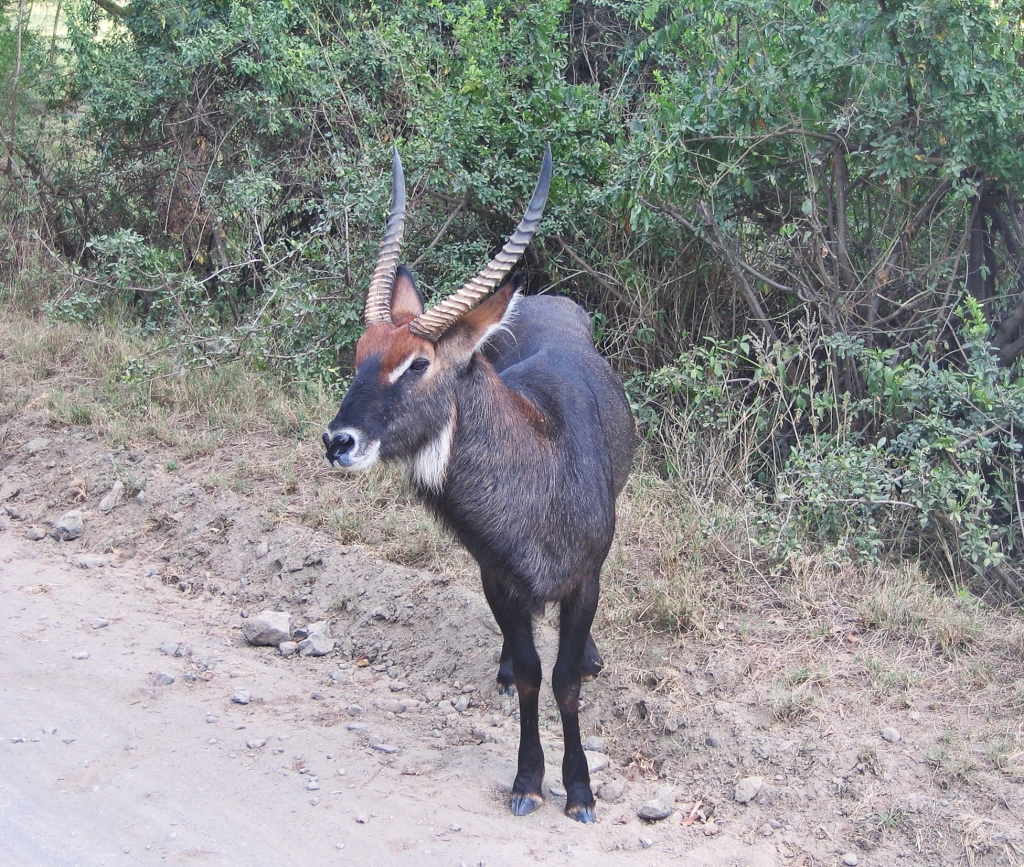
Waterbuck, Maasai Mara National Reserve 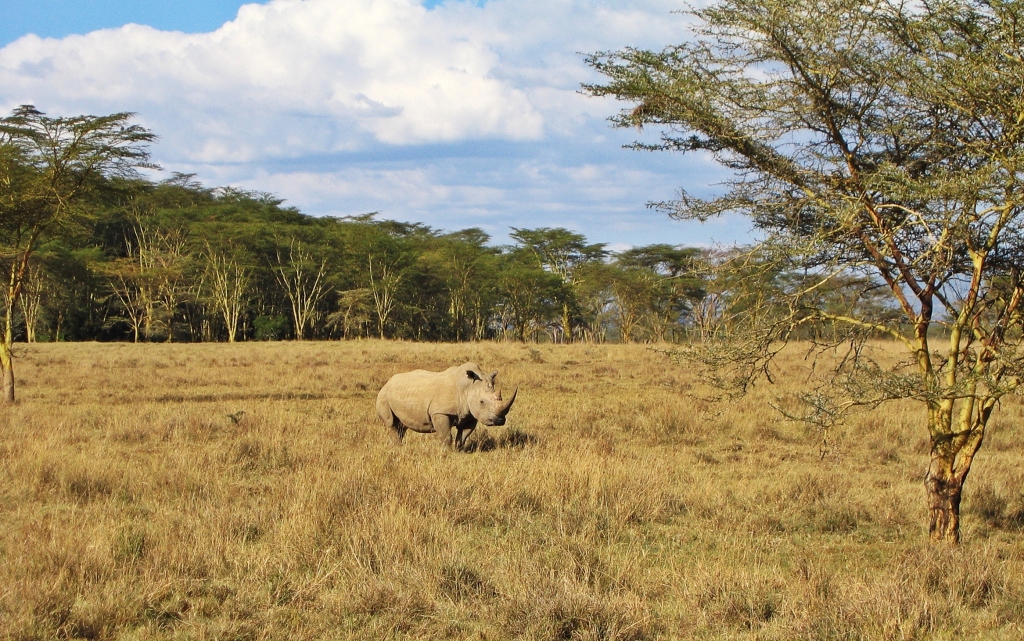
Rhino, Maasai Mara National Reserve 
Baboons, Maasai Mara National Reserve 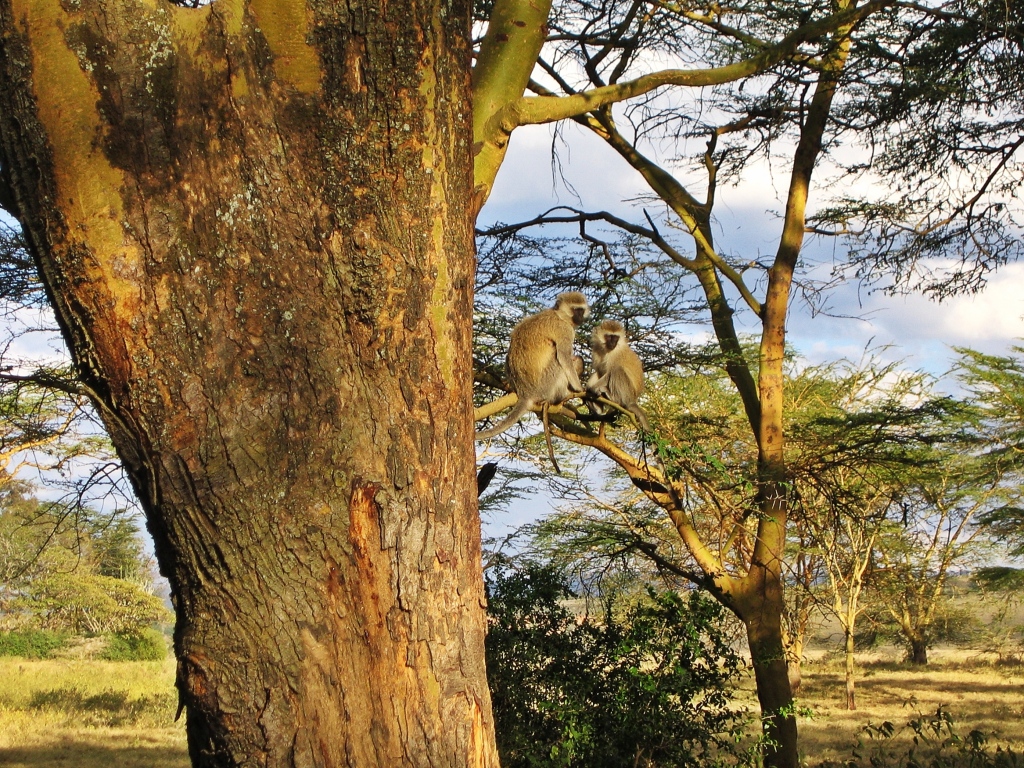
Vervet monkeys, Maasai Mara National Reserve 
Warthogs, Maasai Mara National Reserve 
Hyena, Maasai Mara National Reserve 
Zebras, Maasai Mara National Reserve 
Buffalos, Maasai Mara National Reserve
We weren’t in Kenya during the wildebeest migration but we still went to the Mara River to see where it happens. During the migration millions of wildebeest and other antelopes race across the plains searching for grass after the rainy season. A favourite crossing is the Mara River in Maasai Mara National Reserve. It’s a wide but shallow river with gentle river banks. Resting on those banks were massive crocodiles waiting for their next meal to attempt a river crossing. In the water were dozens of hippopotamuses. Those aren’t all rocks in the last picture below.

Hippo and crocodile, Mara River, Maasai Mara National Reserve 
Mara River, Maasai Mara National Reserve 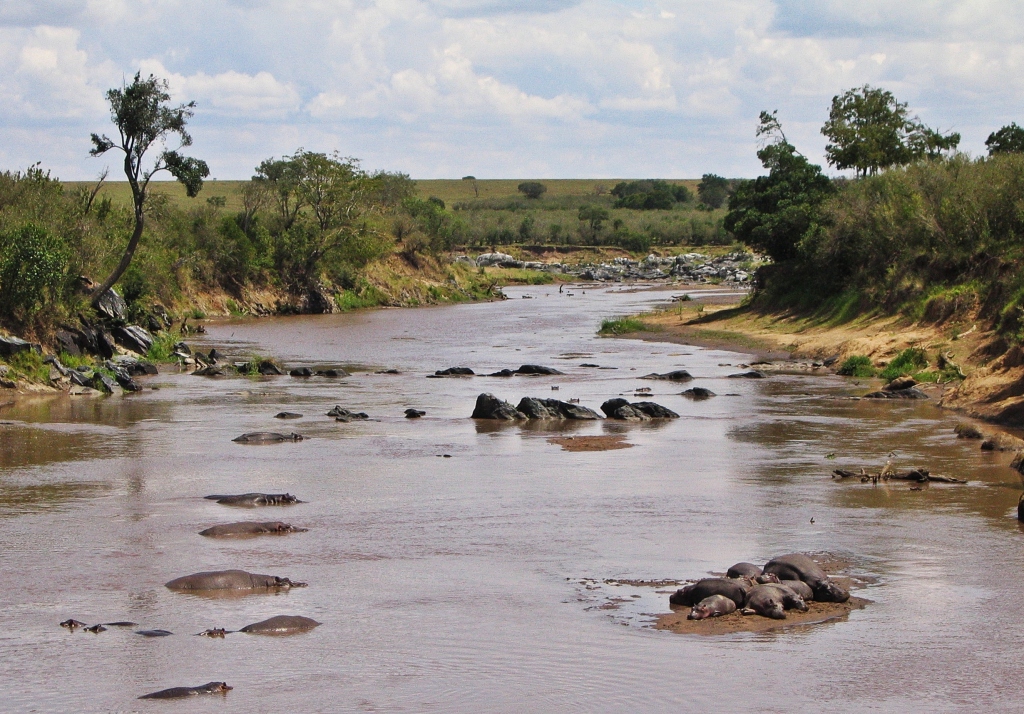
Hippos, Mara River, Maasai Mara National Reserve
One of the funniest scenes was a giraffe fight. Two giraffes stood side by side. They wound up their long necks by stretching it to one side. Then with a powerful force, swung their necks to the other side to hit the other giraffe in the head or neck! We watched them fight for at least 15 minutes and then all of us sudden it ended. We’re not sure who won, but I’m sure they had headaches.

Giraffe fight, Maasai Mara National Reserve 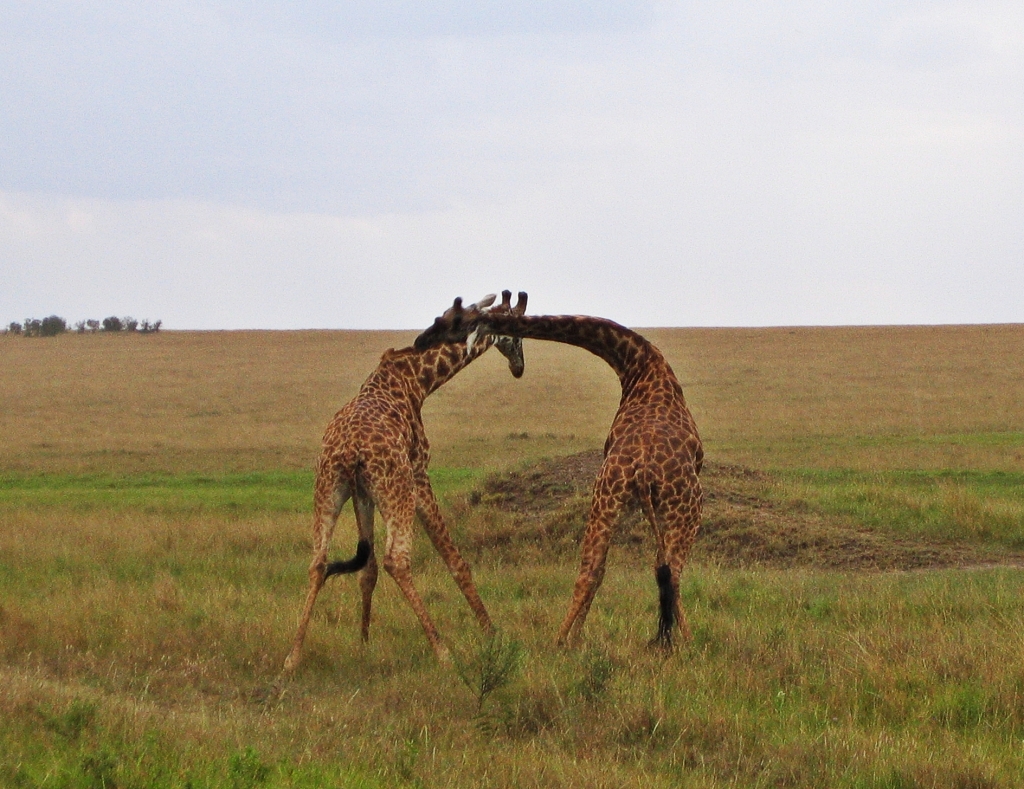
Giraffe fight, Maasai Mara National Reserve
There are many lions in the park. We missed seeing a lion kill an antelope but saw it soon after with it’s lunch.
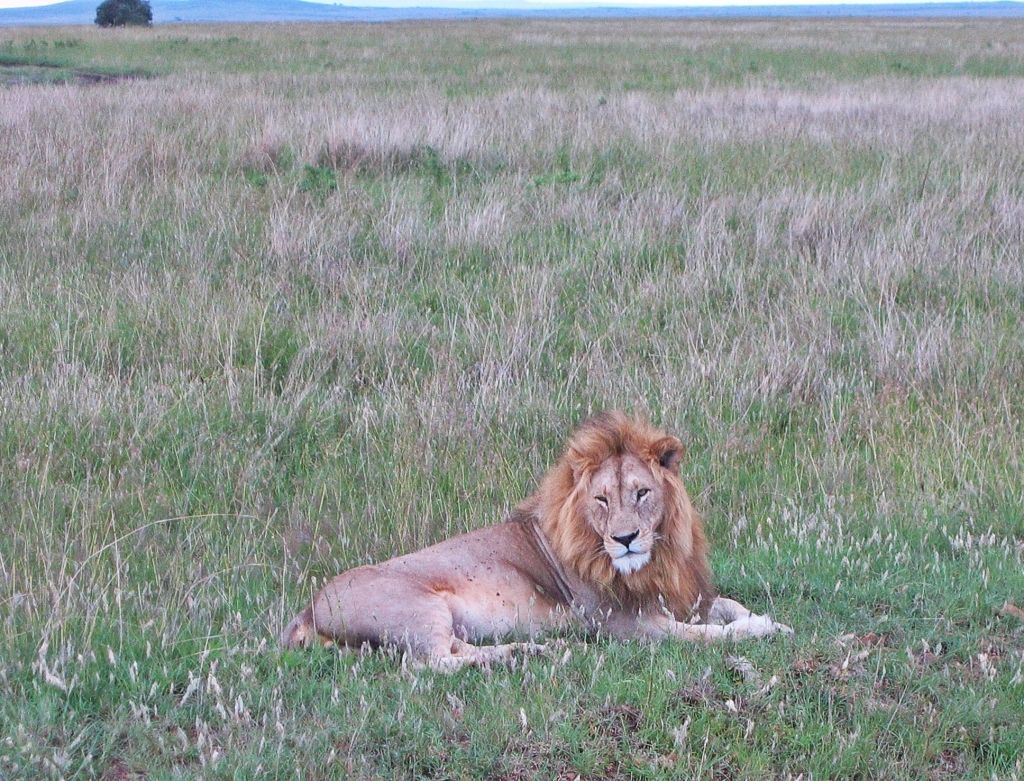
Lion, Maasai Mara National Reserve 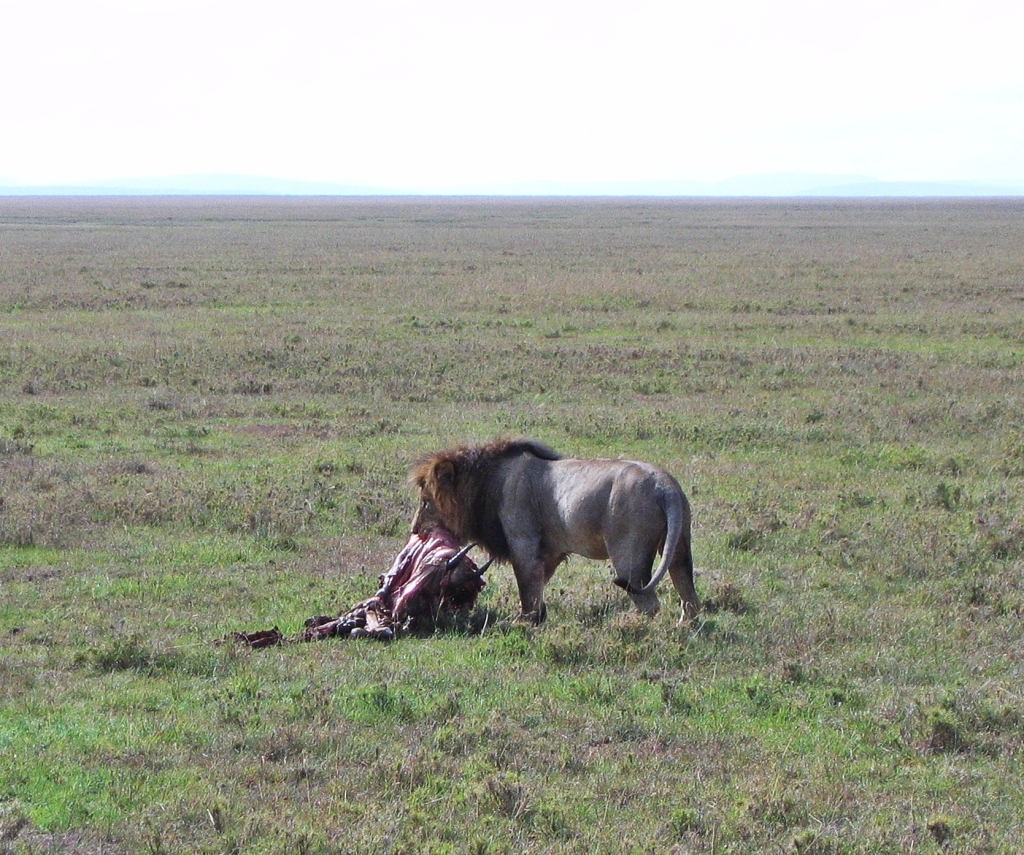
Lion with a kill, Maasai Mara National Reserve 
Lions, Maasai Mara National Reserve
There are many different types of birds in the park. We saw ostriches, pretty cranes and the odd looking secretary bird. There were many flat-topped acacia trees and funny looking sausage tree.

African crowned crane, Maasai Mara National Reserve 
African crowned cranes, Maasai Mara National Reserve 
Secretary bird, Maasai Mara National Reserve 
Ostriches, Maasai Mara National Reserve 
Sausage tree, Maasai Mara National Reserve
Lake Nakuru National Park
The Rift Valley is a deep expansive Kenyan valley with many soda lakes. The lakes are shallow with little drainage and become very alkaline. These conditions are good for algae which is eaten by fish and crustaceans. The large fish population brings many different water birds. Lake Nakuru is a soda lake in the Rift Valley that attracts over 400 species of birds including thousands of flamingos.
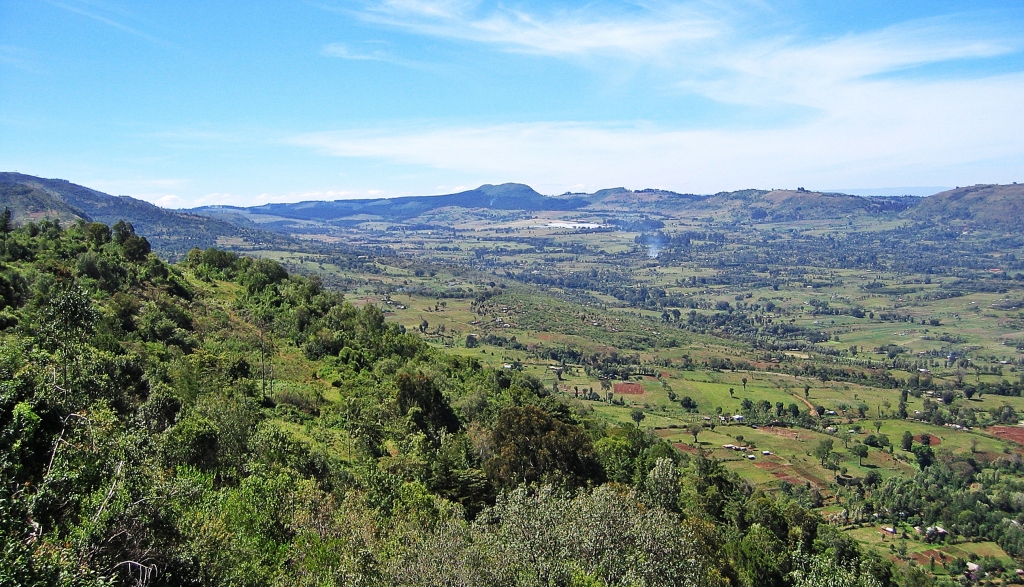
Rift Valley, Kenya 
Flamingos, Lake Nakuru 
Flamingos, Lake Nakuru 
Flamingos and buffalo, Lake Nakuru
The national park surrounds the lake and is filled with grassland and forests which are home to many mammals. It’s not as large as other parks, but its unique setting is a nice spot for a safari.
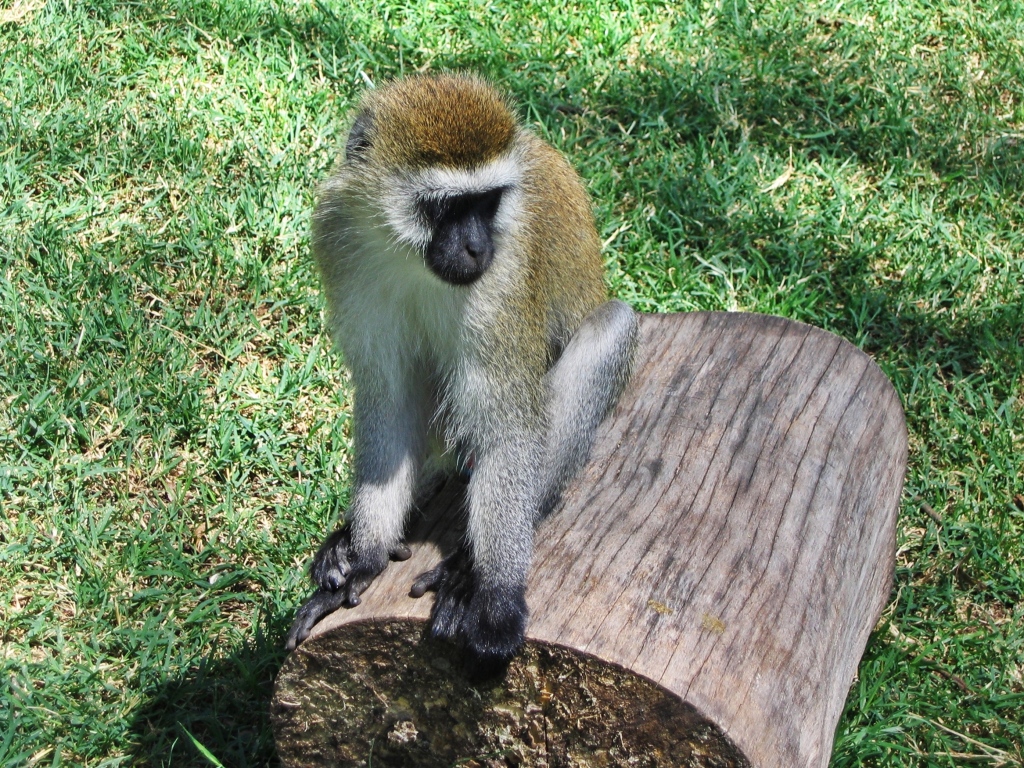
Vervet monkey, Lake Nakuru 
Topi, Lake Nakuru 
African buffaloes, Lake Nakuru 
Lizard, Lake Nakuru 
Gazelles, Lake Nakuru
Coming Next: Climbing in Yosemite
For extra pictures from Kenya click here. For pictures from other blogs go to Gallery at monkeystale.ca
To read about more of our adventures go to Destinations.
If you like what you read, please comment or share (with credit) using the links below.
Beautiful photos – must have been such an amazing life experience!
Also, that lizard looks so scary and BIG! 🙈
LikeLiked by 2 people
Thanks! The lizard wasn’t really scary as he quickly ran away. He was probably twice the length of my hand, so not small, but not too big!
LikeLiked by 2 people
What a fantastic experience. As a former farm boy, I can only imagine the aroma in the huts and paddock. Like you, I would want to be the bad child sent away for education. Thansk for sharing. Stay well. Allan
LikeLiked by 1 person
Thanks Allan, I don’t know how the Maasai could stand it, but I guess it’s what you’re used to. Thanks for reading! Maggie
LikeLiked by 1 person
Amazing safari photos. I also had a chance to meet many Maasai people but over in Tanzania. I remember entering one of their homes and being shown their setup of smart phone chargers – striking to see in an otherwise very basic home with no running water or consistent electricity!
LikeLiked by 1 person
It’s amazing how they live isn’t it. Our village at the time didn’t have any electricity. We went a few years ago so maybe they have solar panels and clean water now. Still, it’s a very difficult life.
LikeLiked by 1 person
Sounds like you had a proper adventure exploring Africa. The Masaai are such extraordinary tribe with extraordinary culture and seeing how they still thrive today must have been real eye opener. I had no idea that giraffes would fight in the way that you described it🙈 Thanks for sharing your travel stories, I love reading them and dreaming about the day we gonna be able to see the world again. Ireland is back into full on lockdown, and we can’t go any further than 5 km from where we live. Take care 😊 Aiva
LikeLiked by 2 people
It was a great adventure. Since we went to Africa for the climbs, we didn’t research into the Maasai people at all. It was fascinating to see how live. I think the giraffe fight was the highlight. It’s still fresh in my mind. I’ve heard in the news that it is getting bad over there again. Canada has a lot more cases no than ever, but we’re still doing quite well compared to other countries. Stay safe and enjoy Netflix! Maggie
LikeLiked by 1 person
Wow, this sounds like a fantastic adventure! Thanks for the culture lesson, I found it fascinating. The more I read about Africa, the higher it moves on my to do list. Great photos also!
LikeLiked by 1 person
Thanks Diana, it’s amazing to see how they still live in mud huts and live off the land. Life is really hard. There are so many interesting places in Africa, so definitely worth a visit or two. We loved the mountains and safaris in Kenya and Tanzania. Maggie
LikeLiked by 1 person
That was an eye-opening anecdote about giraffe fighting. Never knew they did that. As always, fantastic shots and stories. Your choice of destinations is impeccable. Places that truly catch the traveler’s imagination.
LikeLiked by 1 person
Thanks Leighton, it was one of the best things we saw on the safari! Even our guide was impressed. Thanks for reading! Maggie
LikeLiked by 1 person
Lots of wildlife. I find interesting the value inversion of the Maasai people, it makes for reflection.
LikeLiked by 1 person
Yes, it’s interesting that they have some money and could have conveniences, but mostly choose not to. At least not in this village. I think some other are changing/modernizing.
LikeLiked by 1 person
Loved Maasai Mara…love to return.
LikeLiked by 1 person
Thanks for giving us a peek into the lives and culture of tribe and place we know so little about. Wonderful read 👌💟
LikeLiked by 1 person
Thanks, it was an interesting experience for us too. Thanks for reading!
LikeLiked by 1 person
You had fascinating experiences. It isn’t everyone who sees two giraffes fighting!
LikeLiked by 1 person
I know, it was the best part!!!
LikeLiked by 1 person
Beautiful shots!!! I am sooo jealous of the pink flamingos..would love to see them up close! I once read a book called, “I married a Masai”….the worst written book on record. It’s about an Australian (?) woman who fell in love with a Masai man and moved to his village. You can imagine how the story ended…
LikeLiked by 1 person
Thanks Pam, the flamingos were incredible. And we weren’t there at the best time for flamingos! Thanks for the non-recommendation on the book. I can’t imagine what she was thinking!
LikeLiked by 1 person
It was a dumb book…it was ALL over the bookstores when we were in Tanzania…UGH
LikeLiked by 1 person
Such a beautiful description of culture and wild life. Its a life time experience to be at this place.
LikeLiked by 1 person
Thank you, yes it was an amazing trip. Thanks for reading! Maggie
LikeLiked by 1 person
Visiting the village sounds fascinating—so different from our life here. The cow dung/smoke smell and flies would have got to me too. They are such graceful-looking people and I’ve always admired the bright fabrics they use for clothing. Interesting how they send the “bad” child off to the city. Did you sense any resentment from the villagers? We visited a rural village in Zambia (with a guide). People were nice but generally very reserved and I felt a bit odd about looking into their lives. I’m still glad we did it and I guess it’s an important source of income. Your animal photos are great. I’d love to go back to Africa.
LikeLiked by 2 people
It is always awkward to go into these villages, but it’s their primary revenue source I think. We sure didn’t want to stay too long with the smoke, smells and flies. I didn’t feel resentment but they were not happy that we didn’t buy jewelry, even though we paid to be in the village. You can tell they see a lot of tourists because they were not at al curious, just trying to get more money. We’re glad we went but it wasn’t the highlight. I would love to back to Africa though.
LikeLiked by 2 people
Outstanding as always. I really liked your tour of the village not to mention the wildlife photos.
LikeLiked by 1 person
Thanks! It was very interesting to see how they live, so different from anywhere else we’d seen.
LikeLike
What an amazing looking experience! The photos are stunning!
LikeLiked by 1 person
Thank you!
LikeLike
Beautiful pictures of the Masai people. Such colourful clothing that contrasts beautifully with the brown dirt and huts. Interesting that they consider sending a “bad” child to school…such a different perspective than our Western view of things. Looks like you had wonderful weather here. The photos of the animals are stunning!
LikeLike
Some great shots in this post. I’m always fascinated by wild animals roaming their native habitats, and you were lucky to spot some of the most beautiful species in Africa. The Maasai people look so graceful, and I love those bright fabrics they wear. I wonder what they think of people who live in cities, so much so they send their naughty kids there.
LikeLiked by 2 people
Thanks Bama. When we were on the safari we couldn’t believe the amount of animals we saw. We thought of our parks where the animals are hidden in the forest and run away when they hear people. The village was very eye- opening. I really think they believe their way of life is better, and the city is evil. Nairobi is not the nicest city so maybe they’re partly correct. Still I’d rather be the naughty one.
LikeLiked by 2 people
Me too! 🙂
LikeLiked by 1 person
incredible shots and incredible place on earth thanks so much for sharing
LikeLiked by 1 person
Thanks Andy!
LikeLike
Awesome pictures! Nice and interesting to know about Massai tribe and their culture!
LikeLiked by 1 person
I thought I replied to you already, so if this is a second response, I’m sorry. Anyway, it was a very interesting visit to the Maasai village. I can’t imaging living like that. Thanks for reading! Maggie
LikeLiked by 1 person
Very impressive. Thanks for sharing!
LikeLike
What a fantastic adventure, not sure we could have coped with the smell and the flies in the village.! Such colourful and interesting people and the ladies are so elegant. Great photos too. We are yet to visit Kenya but our village experiences in Tanzania were interesting, we certainly have to experience more African countries.
LikeLiked by 2 people
It was a great trip with both amazing animals and unique cultural visit. We’re glad we went to the village, but I can’t imagine ever going back knowing what we know 🙂
LikeLiked by 1 person
What a trip! Your pictures are gorgeous and so crystal clear. I feel like I’ve been on safari for having seen them. We had a similar experience visiting traditional Hmong and Lowland Lao villages in Laos. It was so dark inside their homes, even on the brightest day. Not an easy life, for sure, but they seemed happy.
LikeLiked by 1 person
Now add the smell of cow dung to that! I don’t know how they could stand it, but it’s all they know.
LikeLiked by 1 person
Oh this is a beautiful tale indeed. I’ve heard and watched videos of the Maasai Mara but never so detailed like yours. Great job!
You see, this gives me an idea. Maybe we don’t have to be so scared of lions and wild animals if a colony can sleep at night surrounded by them.
The animals are beautiful and all fat. I’m really wondering if keeping wildlife in zoo is what makes them lose good weight.
Great work again, I like the caption on your images too. How did you do them?
LikeLiked by 1 person
Thank you so much! I try to give enough information without feeling like I’m Wikipedia.😊 The lions in the parks we visited in both Kenya and Tanzania looked very healthy. There was so much wildlife, they had no reason to go hungry. That’s probably not the case everywhere.
For the pictures I use Block Editor Gallery. In Media there are 3 spots for captions. I fill in all three, but I don’t fill out the ‘details’ box. Does that make sense? Then if you display as Gallery they how up. Some others such as Mosaic (I think) don’t show the captions.
LikeLike
Thanks so so much for the super tips!
LikeLiked by 1 person
An incredible journey and with such amazing sightings. It was great to know about the Maasai Tribe and their culture. Thanks for sharing you experiences.
LikeLike
Such an abundance of wildlife! Your photos prove what beauty Africa has…
LikeLiked by 1 person
Thank you. We were very surprised at how many animals there are in the park, and how close we got to them. I’m not sure if that’s a good thing or not, but we enjoyed it! Thanks for reading!
LikeLiked by 1 person
Incredible photos!! You saw so many amazing animals, and the village looks really interesting. What on earth is a sausage tree? lol
LikeLiked by 1 person
Haha, the sausage tree has some kind of fruit that monkeys eat and the fruit looks like sausages:) In hearing from other bloggers it sounds like we were pretty lucky with our animal sightings, so we’re pretty happy about that!
LikeLike
An enjoyable post to get lost in! So vivid!!
LikeLiked by 1 person
Thanks, It’s a great park for a safari, tons of animals and interesting locals.
LikeLiked by 1 person
🙂
LikeLike
Thank you for the good post and pics 😊🌍
LikeLiked by 1 person
Thank you 🙂
LikeLiked by 1 person
You are welcome 😊
LikeLike